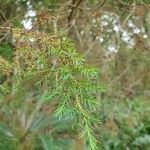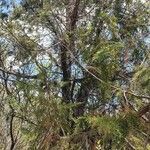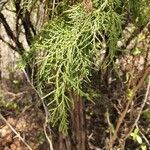Leaves on young plants in threes, subulate, spine-tipped, with an elongate gland abaxially; mature foliage of decussate scale-like leaves, varying in size as the individual ages down to 1 mm. long, abaxial gland elliptic.
Ripe fruit c. 6 mm. in diam., globose, blue-black, with the tips of the scales just distinguishable.
Male cones c. 3 mm. long, elliptic; scales c. 10, each bearing 2–3 pollen-sacs.
Mature seeds 5 mm. long, 1 or 2, brown; aborted seeds 1–3, smaller.<div>
Straight evergreen trees up to 40 m. tall; bark papery, reddish-brown.
Female strobili of 6–8 scales.




